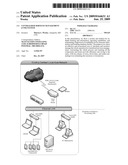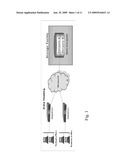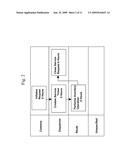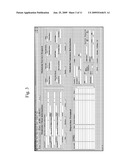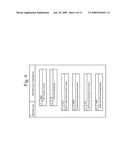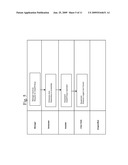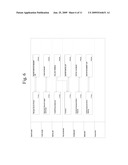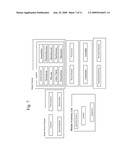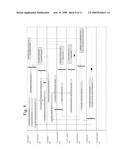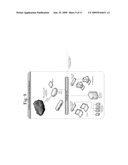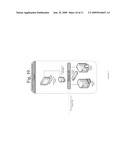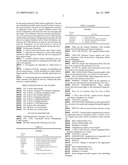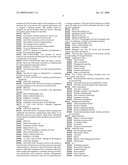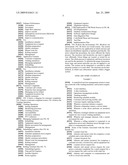Patent application title: Centralized Services Management (CSM) System
Inventors:
Marcus L. Wooley (Annapolis, MD, US)
IPC8 Class: AG06F15173FI
USPC Class:
709225
Class name: Electrical computers and digital processing systems: multicomputer data transferring computer network managing computer network access regulating
Publication date: 2009-06-25
Patent application number: 20090164631
show a system and method for in-depth tracking
and information, reporting capabilities, and maintaining a high level of
availability for its customer information and tracking database facility.
The purpose is to show an effective and economical way to automate and
monitor/manage the whole operation for centralized services management.
Automating the whole process and tracking all the components and issues
provide efficiency and saving to the users, with less chance of error,
down-time, and under-estimating/over-estimating the resources or
inventories.Claims:
1. A centralized services management system to manage a network of the
vending machines, said system comprising:A user interface,A data
warehouse,Operations management module,Tracking module,Monitoring
schedule module,Customer call receiving module, andCustomer inquiry
replying module,Wherein a customer initiates a request,Wherein a
dispatcher creates a service ticket,Wherein a route driver performs an
inventory operation,Wherein a manager initiates an equipment move request
for one or more vending machines,Wherein said manager interacts with a
master movement list, andWherein a rolling terminal is connected to an
application server and a database server through a computer or
communication network.
2. A centralized services management system as recited in claim 1, wherein said system further comprising: a master route list.
3. A centralized services management system as recited in claim 2, wherein said master route list comprises a route schedule and a route driver list.
4. A centralized services management system as recited in claim 1, wherein said system further comprising: a master inventory list.
5. A centralized services management system as recited in claim 4, wherein said master inventory list comprises a customer account, a location list, and an equipment list.
6. A centralized services management system as recited in claim 1, wherein said system further comprising: a master service request list.
7. A centralized services management system as recited in claim 6, wherein said master service request list comprises a customer complaints list, a parts request list, a service request list, and a service work order list.
8. A centralized services management system as recited in claim 1, wherein said computer or communication network is a local area network.
9. A centralized services management system as recited in claim 1, wherein an installer prepares an equipment for move.
10. A centralized services management system to manage a network of the vending machines, said system comprising:A user interface,A data warehouse,Operations management module,Tracking module,Monitoring schedule module,Customer call receiving module, andCustomer inquiry replying module,Wherein a customer initiates a request,Wherein a dispatcher creates a service ticket,Wherein a route driver performs an inventory operation,Wherein a manager initiates an equipment move request for one or more vending machines,Wherein said manager interacts with a master movement list,Wherein said system manages old customer complaints and new customer complaints,Wherein said system manages routing, old tickets, and new tickets, andWherein a delay in the scheduled service or operation triggers a shift or adjustment of tickets in queue, with an automatic notice sent to said customer.
11. A centralized services management system as recited in claim 10, wherein said tracking module comprises an RFID tag.
12. A centralized services management system as recited in claim 10, wherein said tracking module comprises a GPS module to find a coordinate or location.
13. A centralized services management system as recited in claim 10, wherein said automatic notice sent to said customer is done by e-mail or text messaging.
14. A centralized services management system as recited in claim 10, wherein said automatic notice sent to said customer is done by telephone or video-phone.
15. A centralized services management system as recited in claim 10, wherein a scheduler schedules an equipment move request.
16. A centralized services management system as recited in claim 10, wherein a scheduler applies a quality assurance procedure.
17. A centralized services management system as recited in claim 10, wherein said manager optimizes the routing and scheduling.
18. A centralized services management system as recited in claim 10, wherein the scheduling and routing information is stored in a distributed network of databases, computers, storages, or servers.
19. A centralized services management system as recited in claim 10, wherein said system is based on neural network training and fuzzy logic membership function.
20. A centralized services management system as recited in claim 10, wherein the access of different users to said system is based on biometrics, encryption, PKI, password, role-based, context-based, fee-based, permission-based, temporary-based, DRM-based, contract-based, or license-based.Description:
BACKGROUND
[0001]The vending company is serving millions of customers every day through thousands of client sites. XYZ Vending has created a new level of service for its customers with a growing list of restaurant brands and offering a unique dining experience that no one else delivers.
[0002]Project Scope XYZ Vending has a requirement to provide in-depth tracking and information, reporting capabilities, and maintain a high level of availability for its customer information and tracking database facility. The purpose of this patent disclosure is to teach an effective and economical means by which this objective can be accomplished.
[0003]Even with technology which allows the company to read and display another computer's documents, paper reduction goals will never be accomplished without targeted effort to automate. The use of e-mail in an organization causes a two-fold increase in paper consumption. The primary objective of the project is to develop a system to better manage, track, schedule, report and house the data, critical to warehouse operations and management.
[0004]Automating the whole process and tracking all the components and issues provide efficiency and saving to the users, with less chance of error, down-time, and under-estimating/over-estimating the resources or inventories.
[0005]Some prior art/references are: [0006]Sears repair center, for appliances. [0007]U.S. Pat. No. 7,165,041, Web-based architecture sales tool [0008]U.S. Pat. No. 7,149,698, Business alliance identification in a web architecture Framework [0009]U.S. Pat. No. 7,130,807, Technology sharing during demand and supply planning in a network-based supply chain environment [0010]U.S. Pat. No. 7,124,101, Asset tracking in a network-based supply chain environment [0011]U.S. Pat. No. 7,120,928, Secure selective sharing of account information on an internet information aggregation system [0012]U.S. Pat. No. 6,957,186, System method and article of manufacture for building, managing, and supporting various components of a system [0013]U.S. Pat. No. 6,721,713, Business alliance identification in a web architecture framework [0014]U.S. Pat. No. 6,671,818, Problem isolation through translating and filtering events into a standard object format in a network based supply chain [0015]U.S. Pat. No. 6,615,166, Prioritizing components of a network framework required for implementation of technology [0016]U.S. Pat. No. 6,606,744, Providing collaborative installation management in a network-based supply chain environment [0017]U.S. Pat. No. 6,536,037, Identification of redundancies and omissions among components of a web based architecture [0018]U.S. Pat. No. 6,519,571, Dynamic customer profile management [0019]U.S. Pat. No. 6,473,794, System for establishing plan to test components of web based framework by displaying pictorial representation and conveying indicia coded components of existing network framework.
[0020]However, none of the above has the features of the current invention as described below.
SUMMARY
[0021]Statement of Work and Detailed Technical Requirements: Telephone inquires shall be responded to within a timely manner of receipt. If the dispatcher cannot provide an answer to the inquiry, they should alert the customer as to when the customer should expect a resolution. The contractor should adhere to recommended standards for customer service centers, whenever applicable: (1) Responds by technicians within days of calls received; (2) Give callers an estimate of response time; (3) Answer questions or estimate response time within days of receiving original inquiry; and (4) Keep clients abreast of changes to the status.
[0022]Volume of Work: (how many calls, inquires, etc. do you expect to receive?): The dispatcher operating the hotline must make provisions to handle potential spikes of traffic and minimize call waiting times. The Information collected must be entered into the system, in order for viewing and editing by the appropriate individuals or management. The concept of an electronic inbox will be utilized with the information being automatically available to management for scheduling.
[0023]Volume of Work--Email: The current vending operation does not include answering email inquires; therefore, no historical data on email volume exists. XZY Company does not anticipate the volume of email work, which will eventually equal the call volume received.
[0024]Development of Database: The XYZ Vending operator will construct and maintain a database of inquires and response. The dispatcher will be expected, in cooperation with management, to keep the database populated with new questions and response, daily. XYZ Vending will identify new database categories and approve response to the newly-added inquires. This database will be built on the current information available and provided. XYZ Vending will furnish its current database of agencies as a foundation for content and structure. The contractor will develop and populate the database in conjunction with, and to support, the roll-out of the new system.
[0025]Technological Requirements: The contractor shall provide and maintain all technology infrastructures to support the requirements identified in the SOW (statement of work). This includes inquiry processing technology and services, routing and management system, knowledge-base system, database management system, work force management system, customer response automation, complaint management system, service monitoring and quality control system, training equipment, hardware system, and interactive voice mail system. All technology infrastructures, including database designs, shall meet the minimum requirements set forth in the prior section of the contract. Call processing, routing, and management systems shall incorporate automated capabilities to perform periodic checks on the systems to verify operational status of the contractor systems.
[0026]Security Requirement: XYZ Vending shall comply with the corporate information systems security requirements of the base contract, including certification and accreditation (C&A), security plan, test and evaluation, and implementation plan. Guidelines for complying with the corporate information systems security requirements must be strictly adhered to.
[0027]Hardware Requirements: A newly-purchased server configuration would take on the processing needs specifically for the newly proposed CSM software application. The new server hardware would be under warranty for full coverage in the event of a failure. The new server configurations consist of an application server and a separate database server. This server configuration will allow the roles for processing the user logins, user validation, directory searches, and data queries, to be processed on the application server, while the data warehousing and database management processing will take place on a separate database server. Since information contained in the CSM database can then be accessed from any local PC workstation via the web browser, it will not be necessary to purchase any new hardware for the end-users.
[0028]Performance Standards:
[0029]1. Calls are answered 8 hours a day, 5 days a week.
[0030]2. Operators are responsive to every caller, making referrals to other agencies, when the call is not germane to their subject matter.
[0031]3. Accurate referral contract information (for service providing organization) is maintained and readily available to all operators.
[0032]4. All inquires are responded to, within hours or days.
[0033]5. Reports of activity--progress, case handling, and all associated metrics--will be furnished in a future release. Report specifics will be based on mutually-agreed-upon criteria.
[0034]6. Cooperating agencies in identified cities are identified, screened, and approved (Service outlined and maintained in a usable database).
BRIEF DESCRIPTION OF THE FIGURES
[0035]FIG. 1 shows data hosting.
[0036]FIG. 2 shows a diagram for customer complaints.
[0037]FIG. 3 shows a customer complaint screen.
[0038]FIG. 4 shows the Vending Operation.
[0039]FIG. 5 shows managing equipment.
[0040]FIG. 6 shows a scheduling logistics.
[0041]FIG. 7 shows a Rolling terminal.
[0042]FIG. 8 shows a CSM deployment.
[0043]FIG. 9 shows the environment.
[0044]FIG. 10 shows our environment.
[0045]FIG. 11 shows an overall system.
DETAILED DESCRIPTION
[0046]Task Requirements: Strategic Use Case:
[0047]USE CASE: Centralized Service Management (CSM) System:
[0048]We Will Examine the Following Use Cases:
TABLE-US-00001 TABLE I Use cases: Primary Actor Use Case Customer 1. Initiates Service Request and Orders Customer 2. Initiates Equipment Move Request Manager 3. Creates Equipment Move Request Dispatcher 4. Creates Service Tickets Clerk 5. Log Equipment Inventory Clerk 6. Close Equipment Move and Service Request Route 7. Stock Machines Inventory Driver Technician 8. Prepare Equipment for Move Technician 9. Service Machines Technician 10. Installation and Pickup of Equipment Scheduler 11. Schedule Equipment Move Request Manager 12. Manage all Requests
[0049]These are the Generic Situations, with Possible Options for Each Situation and Generic Questions:
[0050]USE CASE DETAIL: The required business functions.
[0051]USED BY: Business Classes options are: (Customer, Dispatcher, Clerk, Route Driver, Technician, Scheduler, and Manager)
[0052]DESCRIPTION:
[0053]INPUTS: Details what information flows from the user to the system for this particular Use Case.
[0054]OUTPUTS: Details what information flows from the system to the external environment.
[0055]PRE-CONDITIONS: What constraints apply on the inputs (or the internal system, as a whole, in some cases)?
[0056]POST-CONDITIONS: What changes does the Use Case make to the internal system state?
[0057]NORMAL COURSE: What are the sequences of events the user must perform for this particular Use Case?
[0058]SPECIAL REQUIREMENTS: What validity checks does the system apply to the information being processed?
[0059]Now, Let us Examine Each Use Case in More Details: [0060]1. USE CASE DETAIL: Initiate Service Request and Orders (Telephone Fax, Email):
[0061]USED BY: Customer
[0062]DESCRIPTION: Maintenance or sales requested by the customer to be tracked and managed through the application.
[0063]INPUTS: Calls are received from customer or sales person.
[0064]OUTPUT: Trouble ticket assignment and routed to the appropriate driver for machine service. A history of service request and orders will be recorded for each customer site.
[0065]PRE-CONDITIONS: N/A
[0066]POST-CONDITIONS: N/A
[0067]NORMAL COURSE:
[0068]Dispatcher log callers service request. [0069]2. USE CASE DETAIL: Initiate Equipment Move Request (Telephone Fax, Email):
[0070]USED BY: Customer
[0071]DESCRIPTION: Equipment move requested to be tracked and managed through the application.
[0072]INPUTS:
[0073]OUTPUT: Request is elevated to the appropriate manager.
[0074]PRE-CONDITIONS: N/A
[0075]POST-CONDITIONS: N/A
[0076]NORMAL COURSE:
[0077]Route manager forwards request to the scheduling managers. [0078]3. USE CASE DETAIL: Initiate Equipment Move Request
[0079]USED BY: Manager
[0080]DESCRIPTION: Initiated by negotiated changes between management and the customer representative. The transfer of machines from one place (warehouse or customer) to another, and will identify where, within each customer location, the machines can be found. Logging the move request into the database requires the assignment of a tracking number. This number cannot be changed, nor can the machine transfer be erased, although the request can be changed or cancelled.
[0081]INPUT: Request is elevated to the appropriate manager.
[0082]Machine(s) transferred out of a Customer or Warehouse.
[0083]Machine(s) transferred into a Customer or Warehouse.
[0084]Dispatch request assigned to Route Driver for inventory operations.
[0085]Close out Service Request.
[0086]OUTPUT: Equipment move request form must be completed for machines operated by Vendor.
[0087]PRE-CONDITIONS: User security for move request is role-based and will determine who can create, view, or change the move request.
[0088]POST-CONDITIONS: N/A
[0089]NORMAL COURSE:
[0090]Manager log callers move request.
[0091]Request can be viewed or printed, and possibly correct any of the tickets in this history. [0092]4. USE CASE DETAIL: Create Service Ticket
[0093]USED BY: Dispatcher
[0094]DESCRIPTION: Orders are used to record all sales to customers. Purchases are also used to record all purchases from suppliers. Routing issues are used to record all inventory operations of product from the warehouse to each route. Service calls are used to record Machine malfunctions requiring technicians. Machine parts request are initiated by the technician. Logging the service request into the database requires the assignment of a tracking number. This number cannot be changed, nor can the machine transfer be erased, although the request can be changed or cancelled.
[0095]INPUTS: Ticket type options are: (Orders, Purchases, Inventory Operations, Service Calls, Parts Request, and Machine Transfers):
[0096]Service Call Information.
[0097]Machine and Location Information.
[0098]Dispatch request assigned to Route Driver.
[0099]Close out Service Request.
[0100]OUTPUT: Request is elevated to the appropriate manager. Route driver is assigned to trouble ticket.
[0101]PRE-CONDITIONS: User security for service request is role-based and will determine who can create, view, or change the service ticket.
[0102]POST-CONDITIONS: N/A
[0103]NORMAL COURSE:
[0104]Dispatcher must be able to open or retrieve a ticket at the start of a phone call.
[0105]Dispatcher forwards request to the appropriate route drivers.
[0106]Request can be viewed or printed, and possibly correct any of the tickets in this history. [0107]5. USE CASE DETAIL: Log Equipment Inventory
[0108]USED BY: Clerk
[0109]DESCRIPTION: The amount of product transferred into the selected warehouse, or from one of your other warehouses. Total shipments directly from the warehouse during a time period. This includes parts usage on service tickets and returned equipment that increases the warehouse inventory. Have an individual data enter the information into the database system.
[0110]INPUTS:
[0111]Warehouse counts before any activity on that date.
[0112]Total purchases received from inventory suppliers.
[0113]Total products transferred into the warehouse.
[0114]Warehouse counts after all other activities for the day were finished.
[0115]OUTPUT: Update to the database will include preparer's and approver's signature information, as well as date-time-stamp.
[0116]PRE-CONDITIONS: N/A
[0117]POST-CONDITIONS: N/A
[0118]NORMAL COURSE: [0119]6. USE CASE DETAIL: Close Equipment Move and Service Request
[0120]USED BY: Clerk
[0121]DESCRIPTION: Equipment installer must notify the Clerk of the completion information.
[0122]INPUTS:
[0123]Tracks the signature information for each movement process.
[0124]Updates the database system.
[0125]OUTPUT: Request is completed, and account status updated.
[0126]PRE-CONDITIONS: N/A
[0127]POST-CONDITIONS: N/A
[0128]NORMAL COURSE: [0129]7. USE CASE DETAIL: Stock Machines Inventory
[0130]USED BY: Route Driver
[0131]DESCRIPTION: The route driver function related to restocking inventory or delivering the order.
[0132]INPUTS:
[0133]Inventory levels at the beginning of each day or period.
[0134]Total sales during the day or time period.
[0135]Total product issued to drivers during the time period.
[0136]Total returns from driver during the time period.
[0137]Inventory levels at the end of the day or period.
[0138]OUTPUT: Detail service activities by subcontract account or vending branch.
[0139]PRE-CONDITIONS: N/A
[0140]POST-CONDITIONS: N/A
[0141]NORMAL COURSE: [0142]8. USE CASE DETAIL: Prepare Equipment for Move
[0143]USED BY: Technician
[0144]DESCRIPTION: Checklist of items related to the machine Prep process.
[0145]INPUTS:
[0146]OUTPUT: Request is elevated to the appropriate manager.
[0147]PRE-CONDITIONS: N/A
[0148]POST-CONDITIONS: N/A
[0149]NORMAL COURSE: [0150]9. USE CASE DETAIL: Service Machines
[0151]USED BY: Technician
[0152]DESCRIPTION: When a service call is actually dispatched to the appropriate technician or manager. Service machines records all repairs either in the warehouse or at the customer site. Every service call or general maintenance call is assigned a tracking number. This number cannot be changed, nor can the machine transfer be erased. Although, the request can be changed or cancelled.
[0153]INPUTS:
[0154]Labor hours and parts request for service call
[0155]Number of parts used for service call.
[0156]Total labor and parts cost for service call.
[0157]The number of service tickets entered.
[0158]The average hours to respond.
[0159]The total time on location making repairs.
[0160]Close out Machine service.
[0161]OUTPUT: Request is completed, and dispatcher is notified of account status updates.
[0162]PRE-CONDITIONS: User security for service request is role-based and will determine who can create, view, or change the service ticket.
[0163]POST-CONDITIONS: When the repair is accomplished. The service call cannot be posted or completed until the repair information has been entered.
[0164]NORMAL COURSE:
[0165]You can assign a call to one of the technicians before they call in.
[0166]The service request is dispatched to a technician normally by phone or radio. [0167]10. USE CASE DETAIL: Installation and Pickup of Equipment
[0168]USED BY: Technician
[0169]DESCRIPTION: Physical movement of equipment from the warehouse to the customer account/location.
[0170]INPUTS:
[0171]OUTPUT: Request is elevated to the appropriate manager.
[0172]PRE-CONDITIONS: N/A
[0173]POST-CONDITIONS: N/A
[0174]NORMAL COURSE:
[0175]Calls are received from Customer.
[0176]Dispatcher forwards call to Route Manager. [0177]11. USE CASE DETAIL: Schedule Equipment Move Request
[0178]USED BY: Scheduler
[0179]DESCRIPTION: Coordinated effort to handle both equipment and inventory management with respect to an individual customer and location. Multi-Route scheduling will be required to handle both the installers and route driver's schedules.
[0180]INPUTS:
[0181]Master Movement List.
[0182]Equipment Install Calendar.
[0183]Master Route List.
[0184]OUTPUT: Installation Calendar of events.
[0185]PRE-CONDITIONS: N/A
[0186]POST-CONDITIONS: N/A
[0187]NORMAL COURSE: [0188]12. USE CASE DETAIL: Manage all the Requests
[0189]USED BY: Manager
[0190]DESCRIPTION: Inventory control is the ability to track the status of both service and move requests at any point within the process. Inventory Control Process provides information to efficiently manage the flow of materials, effectively utilize people and equipment, coordinate internal activities, and communicate with customers. Inventory Management and the activities of Inventory Control do not make decisions or manage operations. They provide the information to Managers who make more accurate and timely decisions to manage their operations.
[0191]INPUTS:
[0192]Master Movement List.
[0193]Equipment Install Calendar.
[0194]Master Route List.
[0195]Master Complaint List.
[0196]OUTPUT: Each Request call can be assigned a priority: Low, Medium, or High for immediate attention.
[0197]PRE-CONDITIONS: N/A
[0198]POST-CONDITIONS: N/A
[0199]NORMAL COURSE:
[0200]Managers can view all service and movement requests and status information.
[0201]These are the Components of Our System, and the Corresponding Advantages/Features:
[0202]Application vision: [0203]Data Hosting [0204]Office automation [0205]Management reporting [0206]Rapid response [0207]Statistical data [0208]Enhance performance [0209]Improve productivity
[0210]FIG. 1 shows data hosting, featuring value (low cost), security, and access: [0211]Streamlined data collection, maintenance, analysis and reporting [0212]Increased accuracy and completeness of data [0213]Total data access throughout the organization
[0214]Office Automation: [0215]Innovative solutions [0216]Reliable, available, and scaleable [0217]Workflow Management [0218]Data warehouse technology [0219]Equipment tracking [0220]Operations management
[0221]Management Reporting: [0222]Track equipment location [0223]Monitor schedule [0224]Monitor equipment pickup [0225]Monitor equipment delivery [0226]Synchronize pickups, repairs, installs, and inventory operations
[0227]Rapid Response: [0228]Reply to customer inquiry [0229]Inputting customer calls [0230]Coordinate efforts [0231]Procedures [0232]Response measurements
[0233]Statistical Data: [0234]Provide manager reports [0235]Measurable outputs [0236]Accuracy [0237]Speed [0238]Success with challenging problems [0239]Effectiveness
[0240]For: [0241]Scheduling logistics [0242]Prep and QA logistics [0243]Installer logistics [0244]Route logistics [0245]Driver logistics [0246]Dispatcher logistics
[0247]Enhance Performance: [0248]Automation [0249]Procedures [0250]Paper flow reduction [0251]Improve morale [0252]Interruptions resolved more effectively [0253]Staff attitudes [0254]Improve communication
[0255]For: [0256]Installation calendar [0257]Equipment move request [0258]Machine preparation [0259]Quality assurance [0260]Master route list [0261]Rolling terminal [0262]Management
[0263]Application Features [0264]Customer complaints [0265]Vending operations [0266]Managing equipment [0267]Scheduling [0268]Rolling terminal service
[0269]For: [0270]Installation calendar [0271]Equipment move request [0272]Machine preparation [0273]Quality assurance [0274]Master route list [0275]Rolling terminal [0276]Management
[0277]Customer Complaints [0278]Customer call volume [0279]Response time management [0280]Managing service tickets [0281]Equipment inventory log [0282]Quality assurance
[0283]FIG. 2 shows a diagram for customer complaints. FIG. 3 shows a customer complaint screen. FIG. 4 shows the Vending Operation.
[0284]Vending Operations [0285]Setting standards [0286]Monitoring processes [0287]Tracking accuracy [0288]Accountability [0289]Inventory reduction [0290]PVV reduction
[0291]Managing Equipment (see FIG. 5) [0292]Scheduling [0293]Equipment request log [0294]Master movement list management [0295]Management
[0296]Scheduling Logistics (See FIG. 6) [0297]Installation calendar [0298]Schedule equipment move request [0299]Machine preparation [0300]Quality assurance procedures [0301]Master route list management [0302]Rolling terminal [0303]Management
[0304]Rolling Terminal (See FIG. 7) [0305]Scheduling logistics [0306]Prep and QA logistics [0307]Installer logistics [0308]Route logistics [0309]Equipment logistics [0310]Dispatcher logistics
[0311]CSM Deployment (CSM Work Process in FIG. 8) [0312]H/S Requirements [0313]Database Architectural Design [0314]Software Application Design [0315]Data Migration Plan [0316]Code/Build Phase and Document [0317]Test Plan [0318]Implementation Plan
[0319]FIG. 9 shows the environment. FIG. 10 shows our environment. FIG. 11 shows an overall system. The system above can be used for any application in which services and objects are distributed, repaired, or updated, periodically. The more ordered the procedures, the more efficient the whole process. The resources and inventories are used or applied very efficiently. Fewer things are wasted, or stored for no reason. The whole process is optimized, and fewer resources are used for the operation. To optimize the usage of resources, fuzzy logic and neural networks can also be applied to our system. The system can be integrated or cascaded to other payment systems or to each other. The structure can be hierarchical, in which case subsystems operate within a bigger system.
HERE ARE SOME EXAMPLES
Example 1
[0320]A centralized services management system to manage a network of the vending machines, said system comprising: [0321]A user interface, [0322]A data warehouse, [0323]Operations management module, [0324]Tracking module, [0325]Monitoring schedule module, [0326]Customer call receiving module, and [0327]Customer inquiry replying module, [0328]Wherein a customer initiates a request, [0329]Wherein a dispatcher creates a service ticket, [0330]Wherein a route driver performs an inventory operation, [0331]Wherein a manager initiates an equipment move request for one or more vending machines, [0332]Wherein said manager interacts with a master movement list, and [0333]Wherein a rolling terminal is connected to an application server and a database server through a computer or communication network.
[0334]Some of the Features Associated with the Above System Are: [0335]a master route list. [0336]wherein said master route list comprises a route schedule and a route driver list. [0337]a master inventory list. [0338]wherein said master inventory list comprises a customer account, a location list, and an equipment list. [0339]a master service request list. [0340]wherein said master service request list comprises a customer complaints list, a parts request list, a service request list, and a service work order list. [0341]wherein said computer or communication network is a local area network. [0342]wherein an installer prepares an equipment for move.
Example 2
[0343]A centralized services management system to manage a network of the vending machines, said system comprising: [0344]A user interface, [0345]A data warehouse, [0346]Operations management module, [0347]Tracking module, [0348]Monitoring schedule module, [0349]Customer call receiving module, and [0350]Customer inquiry replying module, [0351]Wherein a customer initiates a request, [0352]Wherein a dispatcher creates a service ticket, [0353]Wherein a route driver performs an inventory operation, [0354]Wherein a manager initiates an equipment move request for one or more vending machines, [0355]Wherein said manager interacts with a master movement list, [0356]Wherein said system manages old customer complaints and new customer complaints, [0357]Wherein said system manages routing, old tickets, and new tickets, and [0358]Wherein a delay in the scheduled service or operation triggers a shift or adjustment of tickets in queue, with an automatic notice sent to said customer.
[0359]Some of the Features Associated with the Above System Are: [0360]wherein said tracking module comprises an RFID tag. [0361]wherein said tracking module comprises a GPS module to find a coordinate or location, for global positioning. [0362]wherein said automatic notice sent to said customer is done by e-mail or text messaging. [0363]wherein said automatic notice sent to said customer is done by telephone or video-phone. [0364]wherein a scheduler schedules an equipment move request. [0365]wherein a scheduler applies a quality assurance procedure. [0366]wherein said manager optimizes the routing and scheduling. [0367]wherein the scheduling and routing information is stored in a distributed network of databases, computers, storages, or servers. [0368]wherein said system is based on neural network training and fuzzy logic membership function. [0369]wherein the access of different users to said system is based on biometrics, encryption, PKI, password, role-based, context-based, fee-based, permission-based, temporary-based, or license-based.
[0370]Any variation of the above is also intended to be covered by the current disclosure and patent.
Claims:
1. A centralized services management system to manage a network of the
vending machines, said system comprising:A user interface,A data
warehouse,Operations management module,Tracking module,Monitoring
schedule module,Customer call receiving module, andCustomer inquiry
replying module,Wherein a customer initiates a request,Wherein a
dispatcher creates a service ticket,Wherein a route driver performs an
inventory operation,Wherein a manager initiates an equipment move request
for one or more vending machines,Wherein said manager interacts with a
master movement list, andWherein a rolling terminal is connected to an
application server and a database server through a computer or
communication network.
2. A centralized services management system as recited in claim 1, wherein said system further comprising: a master route list.
3. A centralized services management system as recited in claim 2, wherein said master route list comprises a route schedule and a route driver list.
4. A centralized services management system as recited in claim 1, wherein said system further comprising: a master inventory list.
5. A centralized services management system as recited in claim 4, wherein said master inventory list comprises a customer account, a location list, and an equipment list.
6. A centralized services management system as recited in claim 1, wherein said system further comprising: a master service request list.
7. A centralized services management system as recited in claim 6, wherein said master service request list comprises a customer complaints list, a parts request list, a service request list, and a service work order list.
8. A centralized services management system as recited in claim 1, wherein said computer or communication network is a local area network.
9. A centralized services management system as recited in claim 1, wherein an installer prepares an equipment for move.
10. A centralized services management system to manage a network of the vending machines, said system comprising:A user interface,A data warehouse,Operations management module,Tracking module,Monitoring schedule module,Customer call receiving module, andCustomer inquiry replying module,Wherein a customer initiates a request,Wherein a dispatcher creates a service ticket,Wherein a route driver performs an inventory operation,Wherein a manager initiates an equipment move request for one or more vending machines,Wherein said manager interacts with a master movement list,Wherein said system manages old customer complaints and new customer complaints,Wherein said system manages routing, old tickets, and new tickets, andWherein a delay in the scheduled service or operation triggers a shift or adjustment of tickets in queue, with an automatic notice sent to said customer.
11. A centralized services management system as recited in claim 10, wherein said tracking module comprises an RFID tag.
12. A centralized services management system as recited in claim 10, wherein said tracking module comprises a GPS module to find a coordinate or location.
13. A centralized services management system as recited in claim 10, wherein said automatic notice sent to said customer is done by e-mail or text messaging.
14. A centralized services management system as recited in claim 10, wherein said automatic notice sent to said customer is done by telephone or video-phone.
15. A centralized services management system as recited in claim 10, wherein a scheduler schedules an equipment move request.
16. A centralized services management system as recited in claim 10, wherein a scheduler applies a quality assurance procedure.
17. A centralized services management system as recited in claim 10, wherein said manager optimizes the routing and scheduling.
18. A centralized services management system as recited in claim 10, wherein the scheduling and routing information is stored in a distributed network of databases, computers, storages, or servers.
19. A centralized services management system as recited in claim 10, wherein said system is based on neural network training and fuzzy logic membership function.
20. A centralized services management system as recited in claim 10, wherein the access of different users to said system is based on biometrics, encryption, PKI, password, role-based, context-based, fee-based, permission-based, temporary-based, DRM-based, contract-based, or license-based.
Description:
BACKGROUND
[0001]The vending company is serving millions of customers every day through thousands of client sites. XYZ Vending has created a new level of service for its customers with a growing list of restaurant brands and offering a unique dining experience that no one else delivers.
[0002]Project Scope XYZ Vending has a requirement to provide in-depth tracking and information, reporting capabilities, and maintain a high level of availability for its customer information and tracking database facility. The purpose of this patent disclosure is to teach an effective and economical means by which this objective can be accomplished.
[0003]Even with technology which allows the company to read and display another computer's documents, paper reduction goals will never be accomplished without targeted effort to automate. The use of e-mail in an organization causes a two-fold increase in paper consumption. The primary objective of the project is to develop a system to better manage, track, schedule, report and house the data, critical to warehouse operations and management.
[0004]Automating the whole process and tracking all the components and issues provide efficiency and saving to the users, with less chance of error, down-time, and under-estimating/over-estimating the resources or inventories.
[0005]Some prior art/references are: [0006]Sears repair center, for appliances. [0007]U.S. Pat. No. 7,165,041, Web-based architecture sales tool [0008]U.S. Pat. No. 7,149,698, Business alliance identification in a web architecture Framework [0009]U.S. Pat. No. 7,130,807, Technology sharing during demand and supply planning in a network-based supply chain environment [0010]U.S. Pat. No. 7,124,101, Asset tracking in a network-based supply chain environment [0011]U.S. Pat. No. 7,120,928, Secure selective sharing of account information on an internet information aggregation system [0012]U.S. Pat. No. 6,957,186, System method and article of manufacture for building, managing, and supporting various components of a system [0013]U.S. Pat. No. 6,721,713, Business alliance identification in a web architecture framework [0014]U.S. Pat. No. 6,671,818, Problem isolation through translating and filtering events into a standard object format in a network based supply chain [0015]U.S. Pat. No. 6,615,166, Prioritizing components of a network framework required for implementation of technology [0016]U.S. Pat. No. 6,606,744, Providing collaborative installation management in a network-based supply chain environment [0017]U.S. Pat. No. 6,536,037, Identification of redundancies and omissions among components of a web based architecture [0018]U.S. Pat. No. 6,519,571, Dynamic customer profile management [0019]U.S. Pat. No. 6,473,794, System for establishing plan to test components of web based framework by displaying pictorial representation and conveying indicia coded components of existing network framework.
[0020]However, none of the above has the features of the current invention as described below.
SUMMARY
[0021]Statement of Work and Detailed Technical Requirements: Telephone inquires shall be responded to within a timely manner of receipt. If the dispatcher cannot provide an answer to the inquiry, they should alert the customer as to when the customer should expect a resolution. The contractor should adhere to recommended standards for customer service centers, whenever applicable: (1) Responds by technicians within days of calls received; (2) Give callers an estimate of response time; (3) Answer questions or estimate response time within days of receiving original inquiry; and (4) Keep clients abreast of changes to the status.
[0022]Volume of Work: (how many calls, inquires, etc. do you expect to receive?): The dispatcher operating the hotline must make provisions to handle potential spikes of traffic and minimize call waiting times. The Information collected must be entered into the system, in order for viewing and editing by the appropriate individuals or management. The concept of an electronic inbox will be utilized with the information being automatically available to management for scheduling.
[0023]Volume of Work--Email: The current vending operation does not include answering email inquires; therefore, no historical data on email volume exists. XZY Company does not anticipate the volume of email work, which will eventually equal the call volume received.
[0024]Development of Database: The XYZ Vending operator will construct and maintain a database of inquires and response. The dispatcher will be expected, in cooperation with management, to keep the database populated with new questions and response, daily. XYZ Vending will identify new database categories and approve response to the newly-added inquires. This database will be built on the current information available and provided. XYZ Vending will furnish its current database of agencies as a foundation for content and structure. The contractor will develop and populate the database in conjunction with, and to support, the roll-out of the new system.
[0025]Technological Requirements: The contractor shall provide and maintain all technology infrastructures to support the requirements identified in the SOW (statement of work). This includes inquiry processing technology and services, routing and management system, knowledge-base system, database management system, work force management system, customer response automation, complaint management system, service monitoring and quality control system, training equipment, hardware system, and interactive voice mail system. All technology infrastructures, including database designs, shall meet the minimum requirements set forth in the prior section of the contract. Call processing, routing, and management systems shall incorporate automated capabilities to perform periodic checks on the systems to verify operational status of the contractor systems.
[0026]Security Requirement: XYZ Vending shall comply with the corporate information systems security requirements of the base contract, including certification and accreditation (C&A), security plan, test and evaluation, and implementation plan. Guidelines for complying with the corporate information systems security requirements must be strictly adhered to.
[0027]Hardware Requirements: A newly-purchased server configuration would take on the processing needs specifically for the newly proposed CSM software application. The new server hardware would be under warranty for full coverage in the event of a failure. The new server configurations consist of an application server and a separate database server. This server configuration will allow the roles for processing the user logins, user validation, directory searches, and data queries, to be processed on the application server, while the data warehousing and database management processing will take place on a separate database server. Since information contained in the CSM database can then be accessed from any local PC workstation via the web browser, it will not be necessary to purchase any new hardware for the end-users.
[0028]Performance Standards:
[0029]1. Calls are answered 8 hours a day, 5 days a week.
[0030]2. Operators are responsive to every caller, making referrals to other agencies, when the call is not germane to their subject matter.
[0031]3. Accurate referral contract information (for service providing organization) is maintained and readily available to all operators.
[0032]4. All inquires are responded to, within hours or days.
[0033]5. Reports of activity--progress, case handling, and all associated metrics--will be furnished in a future release. Report specifics will be based on mutually-agreed-upon criteria.
[0034]6. Cooperating agencies in identified cities are identified, screened, and approved (Service outlined and maintained in a usable database).
BRIEF DESCRIPTION OF THE FIGURES
[0035]FIG. 1 shows data hosting.
[0036]FIG. 2 shows a diagram for customer complaints.
[0037]FIG. 3 shows a customer complaint screen.
[0038]FIG. 4 shows the Vending Operation.
[0039]FIG. 5 shows managing equipment.
[0040]FIG. 6 shows a scheduling logistics.
[0041]FIG. 7 shows a Rolling terminal.
[0042]FIG. 8 shows a CSM deployment.
[0043]FIG. 9 shows the environment.
[0044]FIG. 10 shows our environment.
[0045]FIG. 11 shows an overall system.
DETAILED DESCRIPTION
[0046]Task Requirements: Strategic Use Case:
[0047]USE CASE: Centralized Service Management (CSM) System:
[0048]We Will Examine the Following Use Cases:
TABLE-US-00001 TABLE I Use cases: Primary Actor Use Case Customer 1. Initiates Service Request and Orders Customer 2. Initiates Equipment Move Request Manager 3. Creates Equipment Move Request Dispatcher 4. Creates Service Tickets Clerk 5. Log Equipment Inventory Clerk 6. Close Equipment Move and Service Request Route 7. Stock Machines Inventory Driver Technician 8. Prepare Equipment for Move Technician 9. Service Machines Technician 10. Installation and Pickup of Equipment Scheduler 11. Schedule Equipment Move Request Manager 12. Manage all Requests
[0049]These are the Generic Situations, with Possible Options for Each Situation and Generic Questions:
[0050]USE CASE DETAIL: The required business functions.
[0051]USED BY: Business Classes options are: (Customer, Dispatcher, Clerk, Route Driver, Technician, Scheduler, and Manager)
[0052]DESCRIPTION:
[0053]INPUTS: Details what information flows from the user to the system for this particular Use Case.
[0054]OUTPUTS: Details what information flows from the system to the external environment.
[0055]PRE-CONDITIONS: What constraints apply on the inputs (or the internal system, as a whole, in some cases)?
[0056]POST-CONDITIONS: What changes does the Use Case make to the internal system state?
[0057]NORMAL COURSE: What are the sequences of events the user must perform for this particular Use Case?
[0058]SPECIAL REQUIREMENTS: What validity checks does the system apply to the information being processed?
[0059]Now, Let us Examine Each Use Case in More Details: [0060]1. USE CASE DETAIL: Initiate Service Request and Orders (Telephone Fax, Email):
[0061]USED BY: Customer
[0062]DESCRIPTION: Maintenance or sales requested by the customer to be tracked and managed through the application.
[0063]INPUTS: Calls are received from customer or sales person.
[0064]OUTPUT: Trouble ticket assignment and routed to the appropriate driver for machine service. A history of service request and orders will be recorded for each customer site.
[0065]PRE-CONDITIONS: N/A
[0066]POST-CONDITIONS: N/A
[0067]NORMAL COURSE:
[0068]Dispatcher log callers service request. [0069]2. USE CASE DETAIL: Initiate Equipment Move Request (Telephone Fax, Email):
[0070]USED BY: Customer
[0071]DESCRIPTION: Equipment move requested to be tracked and managed through the application.
[0072]INPUTS:
[0073]OUTPUT: Request is elevated to the appropriate manager.
[0074]PRE-CONDITIONS: N/A
[0075]POST-CONDITIONS: N/A
[0076]NORMAL COURSE:
[0077]Route manager forwards request to the scheduling managers. [0078]3. USE CASE DETAIL: Initiate Equipment Move Request
[0079]USED BY: Manager
[0080]DESCRIPTION: Initiated by negotiated changes between management and the customer representative. The transfer of machines from one place (warehouse or customer) to another, and will identify where, within each customer location, the machines can be found. Logging the move request into the database requires the assignment of a tracking number. This number cannot be changed, nor can the machine transfer be erased, although the request can be changed or cancelled.
[0081]INPUT: Request is elevated to the appropriate manager.
[0082]Machine(s) transferred out of a Customer or Warehouse.
[0083]Machine(s) transferred into a Customer or Warehouse.
[0084]Dispatch request assigned to Route Driver for inventory operations.
[0085]Close out Service Request.
[0086]OUTPUT: Equipment move request form must be completed for machines operated by Vendor.
[0087]PRE-CONDITIONS: User security for move request is role-based and will determine who can create, view, or change the move request.
[0088]POST-CONDITIONS: N/A
[0089]NORMAL COURSE:
[0090]Manager log callers move request.
[0091]Request can be viewed or printed, and possibly correct any of the tickets in this history. [0092]4. USE CASE DETAIL: Create Service Ticket
[0093]USED BY: Dispatcher
[0094]DESCRIPTION: Orders are used to record all sales to customers. Purchases are also used to record all purchases from suppliers. Routing issues are used to record all inventory operations of product from the warehouse to each route. Service calls are used to record Machine malfunctions requiring technicians. Machine parts request are initiated by the technician. Logging the service request into the database requires the assignment of a tracking number. This number cannot be changed, nor can the machine transfer be erased, although the request can be changed or cancelled.
[0095]INPUTS: Ticket type options are: (Orders, Purchases, Inventory Operations, Service Calls, Parts Request, and Machine Transfers):
[0096]Service Call Information.
[0097]Machine and Location Information.
[0098]Dispatch request assigned to Route Driver.
[0099]Close out Service Request.
[0100]OUTPUT: Request is elevated to the appropriate manager. Route driver is assigned to trouble ticket.
[0101]PRE-CONDITIONS: User security for service request is role-based and will determine who can create, view, or change the service ticket.
[0102]POST-CONDITIONS: N/A
[0103]NORMAL COURSE:
[0104]Dispatcher must be able to open or retrieve a ticket at the start of a phone call.
[0105]Dispatcher forwards request to the appropriate route drivers.
[0106]Request can be viewed or printed, and possibly correct any of the tickets in this history. [0107]5. USE CASE DETAIL: Log Equipment Inventory
[0108]USED BY: Clerk
[0109]DESCRIPTION: The amount of product transferred into the selected warehouse, or from one of your other warehouses. Total shipments directly from the warehouse during a time period. This includes parts usage on service tickets and returned equipment that increases the warehouse inventory. Have an individual data enter the information into the database system.
[0110]INPUTS:
[0111]Warehouse counts before any activity on that date.
[0112]Total purchases received from inventory suppliers.
[0113]Total products transferred into the warehouse.
[0114]Warehouse counts after all other activities for the day were finished.
[0115]OUTPUT: Update to the database will include preparer's and approver's signature information, as well as date-time-stamp.
[0116]PRE-CONDITIONS: N/A
[0117]POST-CONDITIONS: N/A
[0118]NORMAL COURSE: [0119]6. USE CASE DETAIL: Close Equipment Move and Service Request
[0120]USED BY: Clerk
[0121]DESCRIPTION: Equipment installer must notify the Clerk of the completion information.
[0122]INPUTS:
[0123]Tracks the signature information for each movement process.
[0124]Updates the database system.
[0125]OUTPUT: Request is completed, and account status updated.
[0126]PRE-CONDITIONS: N/A
[0127]POST-CONDITIONS: N/A
[0128]NORMAL COURSE: [0129]7. USE CASE DETAIL: Stock Machines Inventory
[0130]USED BY: Route Driver
[0131]DESCRIPTION: The route driver function related to restocking inventory or delivering the order.
[0132]INPUTS:
[0133]Inventory levels at the beginning of each day or period.
[0134]Total sales during the day or time period.
[0135]Total product issued to drivers during the time period.
[0136]Total returns from driver during the time period.
[0137]Inventory levels at the end of the day or period.
[0138]OUTPUT: Detail service activities by subcontract account or vending branch.
[0139]PRE-CONDITIONS: N/A
[0140]POST-CONDITIONS: N/A
[0141]NORMAL COURSE: [0142]8. USE CASE DETAIL: Prepare Equipment for Move
[0143]USED BY: Technician
[0144]DESCRIPTION: Checklist of items related to the machine Prep process.
[0145]INPUTS:
[0146]OUTPUT: Request is elevated to the appropriate manager.
[0147]PRE-CONDITIONS: N/A
[0148]POST-CONDITIONS: N/A
[0149]NORMAL COURSE: [0150]9. USE CASE DETAIL: Service Machines
[0151]USED BY: Technician
[0152]DESCRIPTION: When a service call is actually dispatched to the appropriate technician or manager. Service machines records all repairs either in the warehouse or at the customer site. Every service call or general maintenance call is assigned a tracking number. This number cannot be changed, nor can the machine transfer be erased. Although, the request can be changed or cancelled.
[0153]INPUTS:
[0154]Labor hours and parts request for service call
[0155]Number of parts used for service call.
[0156]Total labor and parts cost for service call.
[0157]The number of service tickets entered.
[0158]The average hours to respond.
[0159]The total time on location making repairs.
[0160]Close out Machine service.
[0161]OUTPUT: Request is completed, and dispatcher is notified of account status updates.
[0162]PRE-CONDITIONS: User security for service request is role-based and will determine who can create, view, or change the service ticket.
[0163]POST-CONDITIONS: When the repair is accomplished. The service call cannot be posted or completed until the repair information has been entered.
[0164]NORMAL COURSE:
[0165]You can assign a call to one of the technicians before they call in.
[0166]The service request is dispatched to a technician normally by phone or radio. [0167]10. USE CASE DETAIL: Installation and Pickup of Equipment
[0168]USED BY: Technician
[0169]DESCRIPTION: Physical movement of equipment from the warehouse to the customer account/location.
[0170]INPUTS:
[0171]OUTPUT: Request is elevated to the appropriate manager.
[0172]PRE-CONDITIONS: N/A
[0173]POST-CONDITIONS: N/A
[0174]NORMAL COURSE:
[0175]Calls are received from Customer.
[0176]Dispatcher forwards call to Route Manager. [0177]11. USE CASE DETAIL: Schedule Equipment Move Request
[0178]USED BY: Scheduler
[0179]DESCRIPTION: Coordinated effort to handle both equipment and inventory management with respect to an individual customer and location. Multi-Route scheduling will be required to handle both the installers and route driver's schedules.
[0180]INPUTS:
[0181]Master Movement List.
[0182]Equipment Install Calendar.
[0183]Master Route List.
[0184]OUTPUT: Installation Calendar of events.
[0185]PRE-CONDITIONS: N/A
[0186]POST-CONDITIONS: N/A
[0187]NORMAL COURSE: [0188]12. USE CASE DETAIL: Manage all the Requests
[0189]USED BY: Manager
[0190]DESCRIPTION: Inventory control is the ability to track the status of both service and move requests at any point within the process. Inventory Control Process provides information to efficiently manage the flow of materials, effectively utilize people and equipment, coordinate internal activities, and communicate with customers. Inventory Management and the activities of Inventory Control do not make decisions or manage operations. They provide the information to Managers who make more accurate and timely decisions to manage their operations.
[0191]INPUTS:
[0192]Master Movement List.
[0193]Equipment Install Calendar.
[0194]Master Route List.
[0195]Master Complaint List.
[0196]OUTPUT: Each Request call can be assigned a priority: Low, Medium, or High for immediate attention.
[0197]PRE-CONDITIONS: N/A
[0198]POST-CONDITIONS: N/A
[0199]NORMAL COURSE:
[0200]Managers can view all service and movement requests and status information.
[0201]These are the Components of Our System, and the Corresponding Advantages/Features:
[0202]Application vision: [0203]Data Hosting [0204]Office automation [0205]Management reporting [0206]Rapid response [0207]Statistical data [0208]Enhance performance [0209]Improve productivity
[0210]FIG. 1 shows data hosting, featuring value (low cost), security, and access: [0211]Streamlined data collection, maintenance, analysis and reporting [0212]Increased accuracy and completeness of data [0213]Total data access throughout the organization
[0214]Office Automation: [0215]Innovative solutions [0216]Reliable, available, and scaleable [0217]Workflow Management [0218]Data warehouse technology [0219]Equipment tracking [0220]Operations management
[0221]Management Reporting: [0222]Track equipment location [0223]Monitor schedule [0224]Monitor equipment pickup [0225]Monitor equipment delivery [0226]Synchronize pickups, repairs, installs, and inventory operations
[0227]Rapid Response: [0228]Reply to customer inquiry [0229]Inputting customer calls [0230]Coordinate efforts [0231]Procedures [0232]Response measurements
[0233]Statistical Data: [0234]Provide manager reports [0235]Measurable outputs [0236]Accuracy [0237]Speed [0238]Success with challenging problems [0239]Effectiveness
[0240]For: [0241]Scheduling logistics [0242]Prep and QA logistics [0243]Installer logistics [0244]Route logistics [0245]Driver logistics [0246]Dispatcher logistics
[0247]Enhance Performance: [0248]Automation [0249]Procedures [0250]Paper flow reduction [0251]Improve morale [0252]Interruptions resolved more effectively [0253]Staff attitudes [0254]Improve communication
[0255]For: [0256]Installation calendar [0257]Equipment move request [0258]Machine preparation [0259]Quality assurance [0260]Master route list [0261]Rolling terminal [0262]Management
[0263]Application Features [0264]Customer complaints [0265]Vending operations [0266]Managing equipment [0267]Scheduling [0268]Rolling terminal service
[0269]For: [0270]Installation calendar [0271]Equipment move request [0272]Machine preparation [0273]Quality assurance [0274]Master route list [0275]Rolling terminal [0276]Management
[0277]Customer Complaints [0278]Customer call volume [0279]Response time management [0280]Managing service tickets [0281]Equipment inventory log [0282]Quality assurance
[0283]FIG. 2 shows a diagram for customer complaints. FIG. 3 shows a customer complaint screen. FIG. 4 shows the Vending Operation.
[0284]Vending Operations [0285]Setting standards [0286]Monitoring processes [0287]Tracking accuracy [0288]Accountability [0289]Inventory reduction [0290]PVV reduction
[0291]Managing Equipment (see FIG. 5) [0292]Scheduling [0293]Equipment request log [0294]Master movement list management [0295]Management
[0296]Scheduling Logistics (See FIG. 6) [0297]Installation calendar [0298]Schedule equipment move request [0299]Machine preparation [0300]Quality assurance procedures [0301]Master route list management [0302]Rolling terminal [0303]Management
[0304]Rolling Terminal (See FIG. 7) [0305]Scheduling logistics [0306]Prep and QA logistics [0307]Installer logistics [0308]Route logistics [0309]Equipment logistics [0310]Dispatcher logistics
[0311]CSM Deployment (CSM Work Process in FIG. 8) [0312]H/S Requirements [0313]Database Architectural Design [0314]Software Application Design [0315]Data Migration Plan [0316]Code/Build Phase and Document [0317]Test Plan [0318]Implementation Plan
[0319]FIG. 9 shows the environment. FIG. 10 shows our environment. FIG. 11 shows an overall system. The system above can be used for any application in which services and objects are distributed, repaired, or updated, periodically. The more ordered the procedures, the more efficient the whole process. The resources and inventories are used or applied very efficiently. Fewer things are wasted, or stored for no reason. The whole process is optimized, and fewer resources are used for the operation. To optimize the usage of resources, fuzzy logic and neural networks can also be applied to our system. The system can be integrated or cascaded to other payment systems or to each other. The structure can be hierarchical, in which case subsystems operate within a bigger system.
HERE ARE SOME EXAMPLES
Example 1
[0320]A centralized services management system to manage a network of the vending machines, said system comprising: [0321]A user interface, [0322]A data warehouse, [0323]Operations management module, [0324]Tracking module, [0325]Monitoring schedule module, [0326]Customer call receiving module, and [0327]Customer inquiry replying module, [0328]Wherein a customer initiates a request, [0329]Wherein a dispatcher creates a service ticket, [0330]Wherein a route driver performs an inventory operation, [0331]Wherein a manager initiates an equipment move request for one or more vending machines, [0332]Wherein said manager interacts with a master movement list, and [0333]Wherein a rolling terminal is connected to an application server and a database server through a computer or communication network.
[0334]Some of the Features Associated with the Above System Are: [0335]a master route list. [0336]wherein said master route list comprises a route schedule and a route driver list. [0337]a master inventory list. [0338]wherein said master inventory list comprises a customer account, a location list, and an equipment list. [0339]a master service request list. [0340]wherein said master service request list comprises a customer complaints list, a parts request list, a service request list, and a service work order list. [0341]wherein said computer or communication network is a local area network. [0342]wherein an installer prepares an equipment for move.
Example 2
[0343]A centralized services management system to manage a network of the vending machines, said system comprising: [0344]A user interface, [0345]A data warehouse, [0346]Operations management module, [0347]Tracking module, [0348]Monitoring schedule module, [0349]Customer call receiving module, and [0350]Customer inquiry replying module, [0351]Wherein a customer initiates a request, [0352]Wherein a dispatcher creates a service ticket, [0353]Wherein a route driver performs an inventory operation, [0354]Wherein a manager initiates an equipment move request for one or more vending machines, [0355]Wherein said manager interacts with a master movement list, [0356]Wherein said system manages old customer complaints and new customer complaints, [0357]Wherein said system manages routing, old tickets, and new tickets, and [0358]Wherein a delay in the scheduled service or operation triggers a shift or adjustment of tickets in queue, with an automatic notice sent to said customer.
[0359]Some of the Features Associated with the Above System Are: [0360]wherein said tracking module comprises an RFID tag. [0361]wherein said tracking module comprises a GPS module to find a coordinate or location, for global positioning. [0362]wherein said automatic notice sent to said customer is done by e-mail or text messaging. [0363]wherein said automatic notice sent to said customer is done by telephone or video-phone. [0364]wherein a scheduler schedules an equipment move request. [0365]wherein a scheduler applies a quality assurance procedure. [0366]wherein said manager optimizes the routing and scheduling. [0367]wherein the scheduling and routing information is stored in a distributed network of databases, computers, storages, or servers. [0368]wherein said system is based on neural network training and fuzzy logic membership function. [0369]wherein the access of different users to said system is based on biometrics, encryption, PKI, password, role-based, context-based, fee-based, permission-based, temporary-based, or license-based.
[0370]Any variation of the above is also intended to be covered by the current disclosure and patent.
User Contributions:
Comment about this patent or add new information about this topic:
| People who visited this patent also read: | |
| Patent application number | Title |
|---|---|
| 20120018278 | Method And Apparatus For Recycle Of Knockout Drum Bottoms |
| 20120018277 | COIN DEPOSITING AND DISPENSING MACHINE |
| 20120018276 | Centrifugal cluth with improved thermal management |
| 20120018275 | Rear Driveline Disconnect Apparatus |
| 20120018274 | METHOD OF OPERATING A DRIVE TRAIN OF A MOTOR VEHICLE AND CORRESPONDING DRIVE TRAIN |

